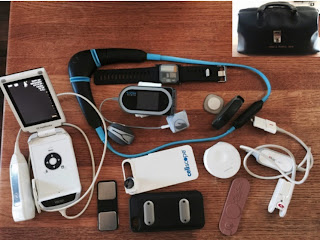Uncertain Health in
an Insecure World – 42
“Innovation Conflation”
The word innovation
has long lost its cachet in business parlance. Ubiquitous, over-hyped and
jargonized, innovation may well be
beyond hope of meaningful use retrieval.
We have previously examined the importance of health
terminology clarity in “Definition-itis”
(see post #14). Now more than ever, a clear definitional framework is essential
to advancing the life sciences innovation ecosystem.
In this vein, and as emphasized by Harvard’s Business
Innovations in Global Health Care program, there are three distinguishable innovation
domains – scientific, entrepreneurial and business.
What isn’t as obvious is the Achilles heel of each.
Whether basic or applied, peer-reviewed research is
foundational to robust scientific discovery and continuing knowledge
advancement. However, irreproducibility is pervasive in the pre-clinical life
sciences research literature. Inability to replicate or verify published
research findings is negatively impacting the development of novel
therapeutics. Having largely divested from internal R&D efforts, big pharma
relies heavily on published studies as the basis for investing in innovative
diagnostics or therapeutics. But the high failure rates of translation from
bench-to-bedside can be traced to flaws in the research process that cause
irreproducibility. In 2013, the Global Biological Standards Institute has
proposed best practices to improve scientific reproducibility. http://gbsi.org/
Products of research flood the intellectual property pipeline, offering entrepreneurial opportunities for commercialization through a process of idea de-risking potentially leading to viable Newco creation. Entrepreneurs embrace risk, ideally timing their investment decisions to prototype deliveries and minimum viable product (MVP) milestones. Their value proposition is usually financial – equity, ROI and market share growth – occasionally with a nod to corporate social responsibility. But for every innovative idea that spawns a Newco, there are a thousand "fail fast" commercialization busts.
The uncoordinated explosion of big data collection & analytics from genomics and other data-intensive life sciences compounds the irreproducibility problem, and adds complexity to Newco. investment timing.
Business innovation has been extensively studied and much
maligned in the Harvard Business Review, Wall Street Journal, Forbes,
Slate.com, etc. The term “disruptive
innovation” was originally coined in 1997 by Harvard Business School
professor Clay Christensen in his excellent book The Innovator’s Dilemma. Back
then, it was a really smart idea… both disruptive and innovative! The
fact that it’s become faddish since isn’t Clay’s fault. As opposed to more
mundane “sustaining innovations”, the
healthcare sector could surely benefit from a Silicon Valley “twice as fast, half as expensive” disruptive
mindset.
Biotech pharma companies sit squarely in the red-hot messy center
of these three innovation domains. Its market growth leaders, companies like
Regeneron, continuously analyze and refine the factors that predict the success
of innovative therapeutics. Regeneron’s mantra is, “driven by science, and motivated by patients”. The big pharma sector
has been challenged by patent expiration, regulatory hurdles and reduced
productivity; the emerging powerhouses of the biotech pharma are facing
business hyper-competitiveness. In the end, as the bigger bubbles below show, biological drugs (B) appear to have
outstripped small molecule drugs (A).
Both big pharma and biotech pharma face the same key innovation challenge – differentiating novel biological mechanism(s) underpinning first-in-class
drugs from best-in-class properties of improved follow-on drugs. Historical
market studies demonstrate that it is better for business to launch first-in-class
drugs instead of best-in-class drugs which have a more limited time window of
business benefit. Of interest, first-to-patent does not predict first- or
best-in-class drugs.
Amid this scientific, entrepreneurial and business
complexity, the F.D.A. is the gatekeeper for first-to-patent new drugs entering
the massive U.S. marketplace. The F.D.A. decides what new drug applications (N.D.A.)
meet criteria for approved use in man based on drug safety and “substantial evidence” of efficacy in
clinical trials. Since the 1980’s, the F.D.A. has expanded the capacity to
expedite N.D.A. approvals based on less rigorous data in circumstances of great
clinical need:
2012 – designated a breakthrough therapy when preliminary evidence suggests substantial improvement over existing therapies
1983 – allowed expedited orphan drug approval for rare diseases
1988 – created fast track approval in response to the AIDS epidemic
1992 – established an accelerated approval pathway allowing surrogate endpoints for using
investigational drugs in a different way2012 – designated a breakthrough therapy when preliminary evidence suggests substantial improvement over existing therapies
Fifty-six percent (56%) of the 312 new molecular entities (N.M.E.)
approved between 2002 and 2013 benefitted from F.D.A. expediting in either clinical
development or regulatory review. The number of NME’s benefitting from more
than one F.D.A. program increased from <20% in 1987 to >40% in 2013,
partly due to an increase in “specialty
drugs” designed to treat smaller subsets of a disease in non-rare patient
populations. European compassionate use
drugs qualify for F.D.A .fast-track status, reducing the average drug approval
timeline from ten to four years.
Presumably, this progressive F.D.A. process change, approved
by the U.S. Congress, incentivizes pharma to continue risking long-haul capital
in search of the next >$1 billion annual sales blockbuster, and that is good for The Economy.
What is unknown is how much longer entrepreneurial
dollars will seek out the solid science behind new biotech drugs when there is likely a faster
ROI to be found in the med-tech & high-tech innovation sectors. But with
Regeneron-Sanofi projected to sell $4.4 billion worth of cholesterol lowering
Praluent, it is hard not to be bullish!
We in the Square understand that new ideas really can’t just equal the best the status quo has to offer… But too often, that's the conflation of what's called innovation.










.jpg)
.jpg)
.jpg)
.jpg)
.jpg)
.jpg)
.jpg)
.jpg)
.jpg)
.jpg)
.jpg)
.jpg)
.jpg)
.jpg)
.jpg)
.jpg)
.jpg)
.jpg)
.jpg)
.jpg)
.jpg)